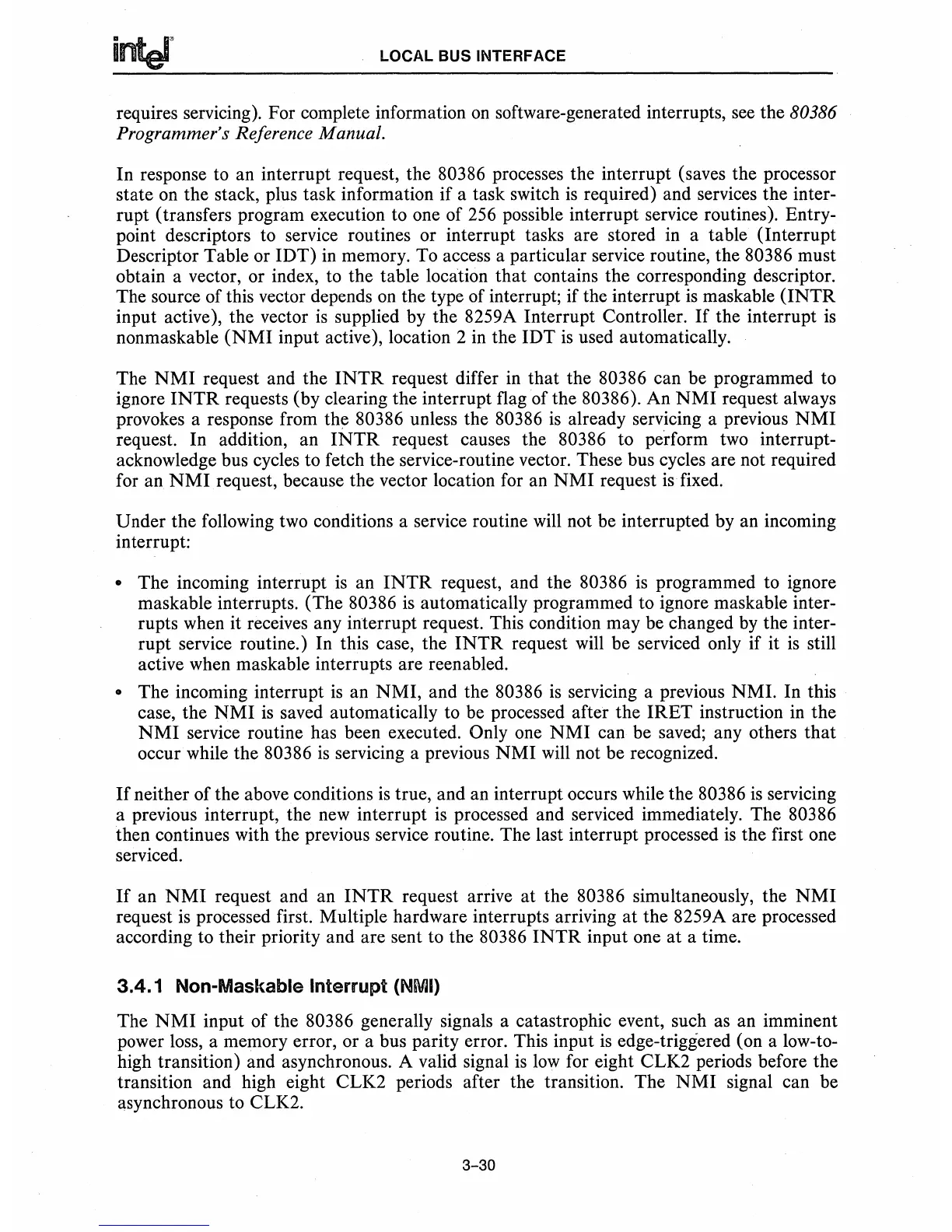inter
LOCAL BUS INTERFACE
requires servicing). For complete information
on
software-generated interrupts,
see
the 80386
Programmer's Reference Manual.
In response to an interrupt request, the
80386 processes the interrupt (saves the processor
state on the stack, plus task information if a task switch
is
required) and services the inter-
rupt (transfers program execution to one of 256 possible interrupt service routines). Entry-
point descriptors to service routines or interrupt tasks are stored in a table (Interrupt
Descriptor Table or
IDT)
in memory. To access a particular service routine, the 80386 must
obtain a vector, or index, to the table location
that
contains the corresponding descriptor.
The source of this vector depends
on
the type of interrupt; if the interrupt
is
maskable
(INTR
input active), the vector
is
supplied by the 8259A Interrupt Controller.
If
the interrupt
is
nonmaskable
(NMI
input active), location 2 in the IDT
is
used automatically.
The
NMI
request and the
INTR
request differ in that the 80386 can be programmed to
ignore
INTR
requests (by clearing the interrupt flag of the 80386). An
NMI
request always
provokes a response from the
80386 unless the 80386
is
already servicing a previous
NMI
request. In addition, an
INTR
request causes the 80386 to perform two interrupt-
acknowledge bus cycles to fetch the service-routine vector. These bus cycles are not required
for an
NMI
request, because the vector location for an
NMI
request
is
fixed.
Under the following two conditions a service routine will not be interrupted by an incoming
interrupt:
• The incoming interrupt
is
an
INTR
request, and the 80386
is
programmed to ignore
maskable interrupts. (The
80386
is
automatically programmed to ignore maskable inter-
rupts when it receives any interrupt request. This condition may be changed
by
the inter-
rupt service routine.) In this case, the
INTR
request will be serviced only if it
is
still
active when maskable interrupts are reenabled.
o The incoming interrupt
is
an
NMI,
and the 80386
is
servicing a previous
NMI.
In this
case, the
NMI
is
saved automatically to be processed after the
IRET
instruction in the
NMI
service routine has been executed. Only one
NMI
can be saved; any others
that
occur while the 80386
is
servicing a previous
NMI
will not be recognized.
If
neither of the above conditions
is
true, and an interrupt occurs while the 80386
is
servicing
a previous interrupt, the new interrupt
is
processed and serviced immediately. The 80386
then continues with the previous service routine. The last interrupt processed
is
the first one
serviced.
If
an
NMI
request and an
INTR
request arrive at the 80386 simultaneously, the
NMI
request
is
processed first. Multiple hardware interrupts arriving at the 8259A are processed
according to their priority and are sent to the
80386
INTR
input one at a time.
3.4.1
Non-Maskable
Interrupt
(NMI)
The
NMI
input of the 80386 generally signals a catastrophic event, such
as
an imminent
power loss, a memory error, or a bus parity error. This input
is
edge-triggered (on a low-to-
high transition) and asynchronous. A valid signal
is
low
for eight CLK2 periods before the
transition and high eight CLK2 periods after the transition. The
NMI
signal can be
asynchronous to CLK2.
3-30

